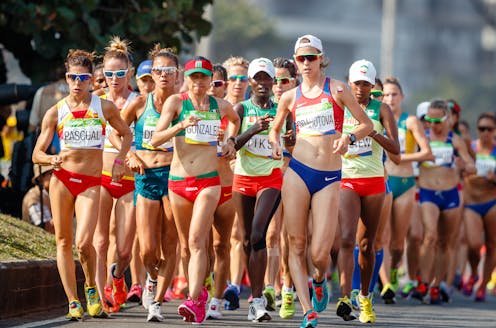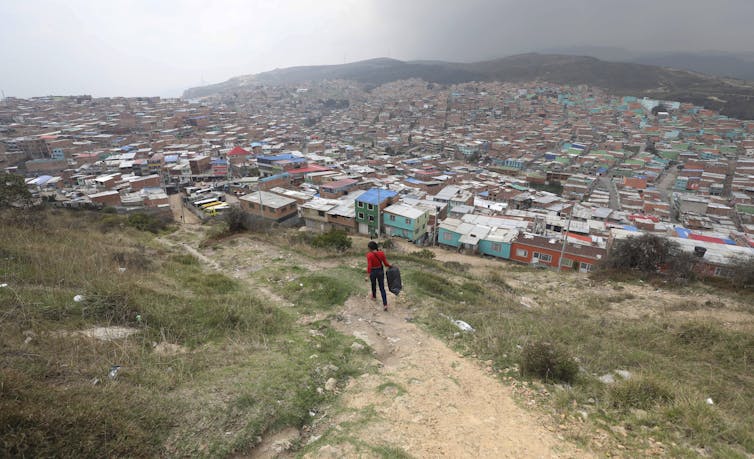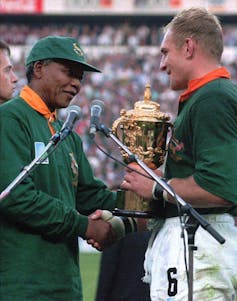
A project implemented in a low-income area of Bogota, Colombia, part of the Sport for Development and Peace initiative, used Olympic race walking as a tool to foster the development of youth from low-income neighbourhoods.
Sport for Development and Peace is an international movement that started with the United Nations Millennium Development Goals from 2000 to 2015, and continued with the Sustainable Development Goals from 2015 to 2030.
The Colombian program, which ran between 1996 and 2012 in the Ciudad Bolivar area but was discontinued eight years ago, helped underprivileged youth. The program used sport to help young people steer clear of the dangers they faced on a daily basis, including alcoholism, violence, prostitution, drug addiction, vandalism and armed gangs.
Read more: How sport for development and peace can transform the lives of youth
As researchers from German, Colombian and Canadian institutions, we have examined how sport has transformed the lives of Colombian youth affected by armed conflict.
50 years of Colombian armed conflict
Colombia has a population of just over 48 million, of which 22.6 per cent are children under the age of 14. For more than 50 years, the country has struggled with a war between the government and various rebel factions that has resulted in more than 220,000 deaths, 81.5 per cent of them civilians and the rest combatants.
According to a 2019 report by the United Nations High Commissioner for Refugees, Colombia has eight million internally displaced persons due to the conflict, the largest number in the world. A Colombian report also found more than two million children and adolescents have been direct victims of the unrest.
Bogotá, the Colombian capital, has more than seven million inhabitants and its territory is divided among 20 localities, known as localidades.
Ciudad Bolivar is among these urban areas struggling with poverty and violence.It has a population of almost 700,000 people in more than 200 neighbourhoods, and is located in the south of the city.

This area is one of the main settlements for displaced people arriving in the city.
Many are slum-dwellers. Although most inhabitants are classified as low-income, 14.5 per cent are classified as people with “unmet basic needs,” meaning they endure inadequate and overcrowded housing and inadequate basic services like electricity and drinking water. This includes school-age children who don’t attend school.
The area is also considered one of the most dangerous in the city, with very few play spaces for children. It’s also risky for them to go anywhere alone due to the presence of street gangs and other illegal groups.
Finally, Ciudad Bolivar is the area in Bogotá with the highest number of children under five years old living in poverty (17 per cent).
Sport’s impact on young Colombians
In 1996, an athletics club called the Escuela de comunidad was established in the area under the responsibility of a physical education teacher.
From the beginning, the club received the support of the school and the community. Due to the success of the project, the Marcha Olimpica Club was born in 1999. Young athletes trained under the palo del ahorcado, an outdoor space that is meaningful to the community.
The objective of the program was twofold.
From the training point of view, the aim was to ensure young people would continue their education in order to obtain technical or professional training that would allow them to earn a living after their retirement from sports.
From an athletic point of view, the program aimed to support young athletes in their athletic development so they could perform to the best of their abilities and achieve important athletic results in their category at the district, national and international levels.
Throughout the years, several athletes qualified for the national championships and the South American Games. Since its creation, eight young people between 13 and 16 years old were selected to compete in the events of 800-, 1,500- and 3,000-metre Olympic race walking.
Six of them qualified for the national intercollegiate competitions.
Spurred enrolment
This initial success attracted an increasing number of youth to register in the club. Subsequently, approximately 100 young athletes began to compete and to win in various competitions, attracting the attention of the international media.
The Bogotá sports authority selected about 40 young people to represent the community in Colombian competition and supported them with various services (transportation, tech, food and health). About 10 of the athletes from this club became national, South American, Pan American and world championship medallists.
The goal of Sport for Development and Peace is to use sport as a vehicle to achieve various social and humanitarian missions: education, social cohesion, health, reintegration, diplomacy and peace.
Sport can serve as a lever for social integration or reintegration in developing countries or areas affected by conflict. For young people in particular, sport can be a means of instilling respect for opponents and rules, teamwork, sportsmanship, determination and discipline.
Read more: How sport for development and peace can transform the lives of youth
Sport can also provide individual development, health promotion and disease prevention, gender equality, social integration, peace-building, conflict prevention and resolution, and disaster and trauma relief. From a development perspective, the objective is to promote sports for the masses, not elite sports.
How sport can change lives and nations
In practice, Sport for Development and Peace can take many forms. It can mean organizing clubs and tournaments in El Salvador to taking back territory from street gangs and getting children into school. Or it may be training coaches in the poorest neighbourhoods in Montréal to mentor children.
In Madagascar, sport is used to keep children busy after school and away from street dangers.
Read more: Les activités artistiques et sportives contribuent au bien-être et à la résilience
It can also take the form of soccer matches between Palestinian and Israeli youth to work on social cohesion and teach them to respect each other.

None of this is new. In 1894, Pierre de Coubertin, the founder of the modern Olympic Games, declared: “I remain convinced that sport is one of the most powerful elements of peace and I am confident in its future action.”
But it was actually the words of Nelson Mandela that inspired the contemporary movement. In a speech at the 2000 Laureus World Sports Awards, he said:
“Sport has the power to change the world. It has the power to inspire, it has the power to unite people in a way that few other things can.”
Indeed, Mandela himself used the power of sport at the 1995 Rugby World Cup, after the official end of apartheid, to unite the South African people — perhaps the best example of the healing nature of sport.
Tegwen Gadais receives funding from the Québec government. He is a consultant to UNESCO and the World Bank. He is affiliated with the UNESCO Chair (cudc.uqam.ca).
Mauricio Garzon, Natalia Varela, and Victoria Calzolari Soto do not work for, consult, own shares in or receive funding from any company or organisation that would benefit from this article, and have disclosed no relevant affiliations beyond their academic appointment.
This article was originally published on The Conversation. Read the original article.







